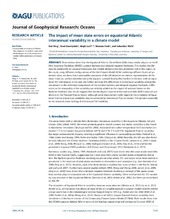The impact of mean state errors on equatorial Atlantic interannual variability in a climate model
Peer reviewed, Journal article
Published version

Åpne
Permanent lenke
https://hdl.handle.net/1956/11199Utgivelsesdato
2015-02-23Metadata
Vis full innførselSamlinger
- Geophysical Institute [1198]
Sammendrag
Observations show that the Equatorial Atlantic Zonal Mode (ZM) obeys similar physics to the El Niño Southern Oscillation (ENSO): positive Bjerknes and delayed negative feedbacks. This implies the ZM may be predictable on seasonal timescales, but models demonstrate little prediction skill in this region. In this study using different configurations of the Kiel Climate Model (KCM) exhibiting different levels of sys- tematic error, we show that a reasonable simulation of the ZM depends on realistic representation of the mean state, i.e., surface easterlies along the equator, upward sloping thermocline to the east, with an equa- torial SST cold tongue in the east. We further attribute the differences in interannual variability among the simulations to the individual components of the positive Bjerknes and delayed negative feedbacks. Differ- ences in the seasonality of the variability are similarly related to the impact of seasonal biases on the Bjerknes feedback. Our results suggest that model physics must be enhanced to enable skillful seasonal pre- dictions in the Tropical Atlantic Sector, although some improvement with regard to the simulation of Equa- torial Atlantic interannual variability may be achieved by momentum flux correction. This pertains especially to the seasonal phase locking of interannual SST variability.